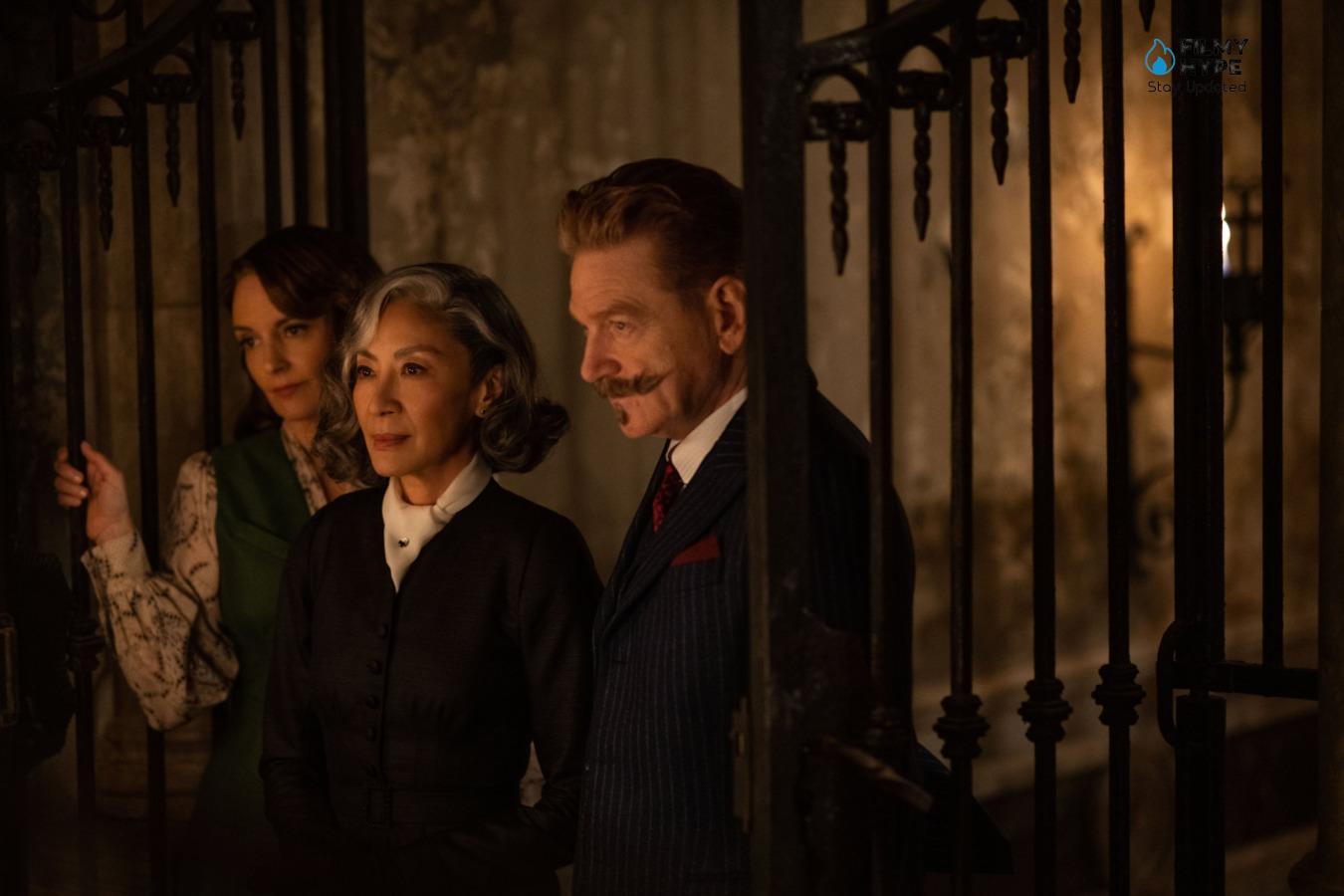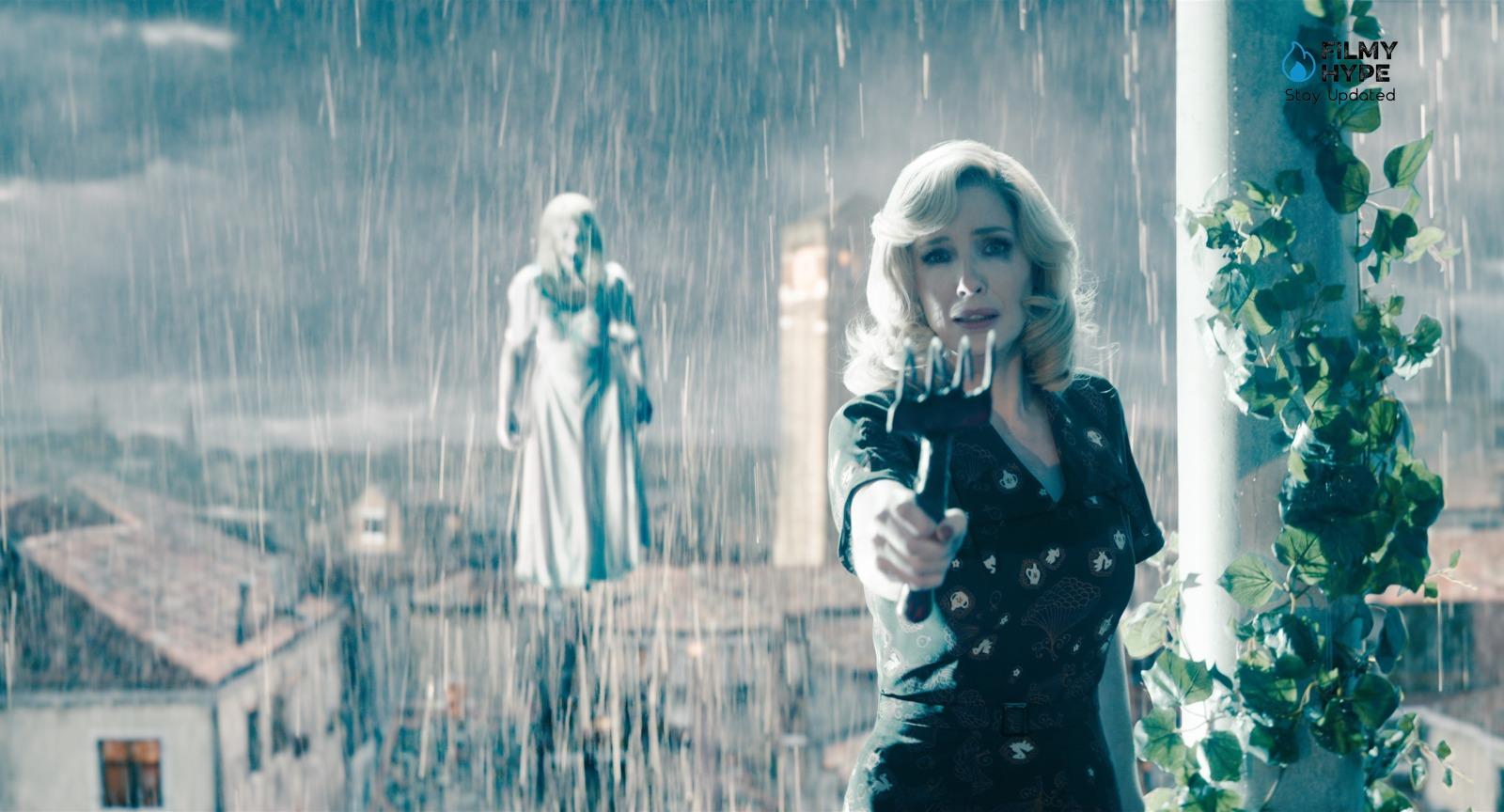A Haunting in Venice Ending Explained: Were Poirot’s Hallucinations Real? Was Joyce Reynolds a Real Medium?
As per tradition, even in the finale of Kenneth Branagh’s A Haunting in Venice – released in cinemas on 14 September – the identity of the killer is revealed, along with obviously his motivations. At the end of the film, the involvement of Rowena Drake’s character (Kelly Reilly) in all three murders at the center of the story (her daughter Alicia Drake, the medium Joyce Reynolds, and Doctor Leslie Ferrier) is confirmed. Poirot, invited by Ariadne Oliver (Tina Fey) to take part in the séance organized in Rowena’s house (the writer intended to demonstrate that there is no basis in truth in these techniques), discovers that the mistress of the house had poisoned his daughter Alicia for a long time with hallucinogenic honey dissolved in tea. Unaware of everything, Rowena’s housekeeper, Olga Seminoff (Camille Cottin), continues to offer honey to the girl, believing it has beneficial effects on her health: one night, however, after giving her a massive dose, Olga unknowingly kills Alicia following an overdose.

At that point, Rowena decides to stage her daughter’s suicide by throwing her into the river, to hide the truth: the woman had thus made it appear that it was the spirits of the house who had convinced Alicia to end it. Subsequently, Rowena begins to receive threatening letters and during the film – believing she has identified those responsible – she goes so far as to kill Joyce Reynolds (Michelle Yeoh) and threaten Leopold, the son of Doctor Ferrier (Jamie Dornan), pushing the doctor to take himself away life to protect it. After Poirot solves the mystery, Rowena attempts to escape, but she falls from the balcony at the hands of Alicia’s ghost (or, at least, that’s what the film lets on). In the aftermath of the incident, Poirot confides to Leopold (Jude Hill) that he has always known that it was he who was blackmailing Rowena: the child had intuited the truth about Alicia’s death thanks to the autopsy notes carried out by his father on the girl’s corpse; he then began to blackmail Rowena to obtain money from the woman and support her father who was in serious financial difficulty.
A Haunting in Venice: The Story Plot
Venice, 1947. Poirot (Kenneth Branagh) has chosen the Lagoon as his retreat after the end of the Second World War. The war conflict has left him disillusioned and embittered, so much so that he has locked himself in his golden Venetian prison, without accepting cases and without wanting to meet anyone, with only his bodyguard Vitale Portfoglio (Riccardo Scamarcio) at his side to shield him from the demands of the world external. However, the writer Ariadne Oliver (Tina Fey) manages to intrigue Poirot, asking for his help in disguising a medium named Joyce Reynolds (Michelle Yeoh) on the eve of a séance. The woman will try to evoke the spirit of the deceased daughter of the soprano singer Rowena Drake (Kelly Reilly), the inconsolable owner of the Palazzo delle Lacrime in Venice. On Halloween night Ariadne and Poirot will participate in the session, as skeptics determined to unmask the scammer. They will find themselves facing a macabre murder that seems somehow linked to the death of Rowena’s daughter. Is there a murderer among the guests or are the spirits of the children who haunt the cursed house the ones who killed?
A Haunting in Venice Ending Explained: Why Does Rowena Stage the Seance?
Let’s start with Rowena. In the finale of A Haunting in Venice, we discover that she is the architect not only of the murder of her daughter but also of the séance at which Poirot assists driven by his friend Ariadne Oliver. The woman, who couldn’t live without Alicia, had decided to control her, devising a plan to distance her from her boyfriend Maxime. To prevent the girl from getting back together with him, Rowena had begun to gradually poison her, every day, through a particular hallucinogenic honey. A year after Alicia’s death, the woman organizes the séance with the medium Joyce Reynolds in an attempt to kill her and Leslie Ferrier, Alicia’s doctor, because she is convinced that both, knowing what happened, are blackmailing her for money. If her plan had been successful, the two would have died with the excuse of revenge on the children, considering that one was a doctor, the other a former war nurse. However, when Poirot arrives, not having foreseen the detective’s presence,
What Did Ariadne and Vitale Want to Achieve by Working Together?
Ariadne Oliver (Tina Fey) is a crime writer as well as an old friend of Poirot, but in reality, she and the detective’s bodyguard, Vitale Portfoglio ( Riccardo Scamarcio), had agreed. Since death seemed to follow Poirot everywhere, Ariadne had decided to take advantage of the detective’s presence at the seance: the writer’s last three novels had been flops and so the woman wanted to convince Poirot to participate in the seance to then write a story based precisely on that experience; from her point of view, in fact, including the detective in the story would have contributed to making the book a success. Furthermore, since Poirot was known to be antisocial and selfish, Ariadne did not contemplate the possibility of feeling guilty for having lied to him.
For his part, Vitale – the only one Poirot trusted before discovering the truth – had agreed to collaborate with Ariadne to finally put an end to the death of Alicia Drake: it will be discovered that it was precisely the unsolved case of a young man to push Vitale to withdraw from his work as a policeman; participating in the séance, therefore, would have provided him with the solution he had been looking for for a long time, that is, finally finding out who had killed Alicia, the man being obsessed by the fact of never having managed to find the culprit.
Were Poirot’s Hallucinations Real?
A Haunting in Venice constantly alludes to the spirits haunting Rowena’s house. Poirot does not believe that ghosts exist but begins to suffer from hallucinations after the landlady contaminates his tea with poisonous honey: from that moment, the detective begins to hear voices of children singing, only to find himself face to face with the ghost of Alicia. Although the film explains what lies behind Poirot’s hallucinations, the viewer is still allowed to create an alternative theory about it: having been close to death for a moment, it is possible that it was this – and not the hallucinogenic honey – the reason why Poirot saw Alicia’s ghost; the honey may have simply unlocked his ability to sense any presences, regardless of whether or not the detective believes such things.
Was Joyce Reynolds a Real Medium?
In the film, it is never clarified whether Joyce Reynolds is a real medium or not. Ariadne, Rowena, and Joyce’s assistants – Nicholas (Ali Khan) and Desdemona (Emma Liard) – believe in the woman’s abilities (even though the two boys had helped stage part of what happened during the séance). Hercule Poirot constantly questions Joyce’s abilities, but she always appears confident in what she is capable of doing, even when her subterfuges are revealed. Based on the evidence provided throughout the film, likely, Joyce was likely capable of perceiving the spirits of the dead and making contact with them, but not of becoming possessed (which would explain her resort to deception).
Is it Alicia’s Ghost That Pushes Rowena from the balcony?
Before Rowena’s death, Poirot sees a spirit floating in the air behind her. It is Alicia’s ghost: the film, therefore, assumes that it was the spirit that pushed the woman from the balcony (exactly as Rowena had done with Alicia). However, due to the hallucinations the detective experiences, it is unclear whether the viewer should believe that Alicia’s ghost appeared at that moment to seek revenge. After Rowena falls into the water, we see Alicia’s spirit drag her mother’s body deeper and deeper. From that moment on, Poirot can no longer see what is happening: consequently, the ghost’s appearance is to be considered authentic, as is the fact that it was the spirit that pushed Rowena from the balcony. Having said that, the last word is always in the eye of the beholder… Also, the detective is the only witness to the woman’s death.

Why Did Poirot Grow a Mustache Again?
At the end of the previous Death on the Nile, Hercule Poirot appears at Salome Otterbourne’s (Sophie Okonedo) jazz club without his famous mustache, which he had grown to cover facial scars resulting from the First World War. In the ten years between that film and A Haunting in Venice, we discover that Poirot has grown them again, although it is never explained why. However, A Haunting in Venice suggests that things between the detective and Salome did not work out and the Poirot has returned to having a closed attitude towards the world and people. Precisely because the third film is set a decade after the second, it can be safely said that Poirot’s choice to live in exile is a consequence of his having realized that death follows him everywhere; in this sense, the mustache is a representation of this return to an alienated life.
Did A Haunting in Venice Pave the Way for a Fourth Film?
After solving Alicia’s murder, Poirot returns home. Instead of locking the door, Poirot decides to leave it open, inviting in a man who – at the beginning of the film – had tried to ask for his help in the murder of his family. Poirot has likely realized that retirement does not suit him at all, since the Drake case has rekindled something within him (as can be seen – precisely – from the help that the detective decides to give to the aforementioned boy). Even if a fourth Branagh film dedicated to Hercule Poirot has not yet been announced, probably, the ending of A Haunting in Venice – with the reference to a new case that must be solved – has deliberately left the door open to a possible return of the iconic detective on the big screen.
The True Meaning of the Ending of A Haunting in Venice?
A Haunting in Venice is the first of Branagh’s films based on the works of Agatha Christie to focus on more than just solving a murder. Given the strong supernatural connotation of the story, the film also addresses a series of rather interesting themes, such as the importance of learning not to hide from one’s ghosts, whether they are real or not. Poirot, for example, hid for a very long time and this allowed him to hide from his ghosts. However, hiding is not the same as facing either your past or the belief that you are haunted by death. Alicia’s case helped Poirot resolve many of his conflicts, making him understand that he could no longer hide forever: the detective needed to look the past in his eyes and be able to move forward relying only on himself.



